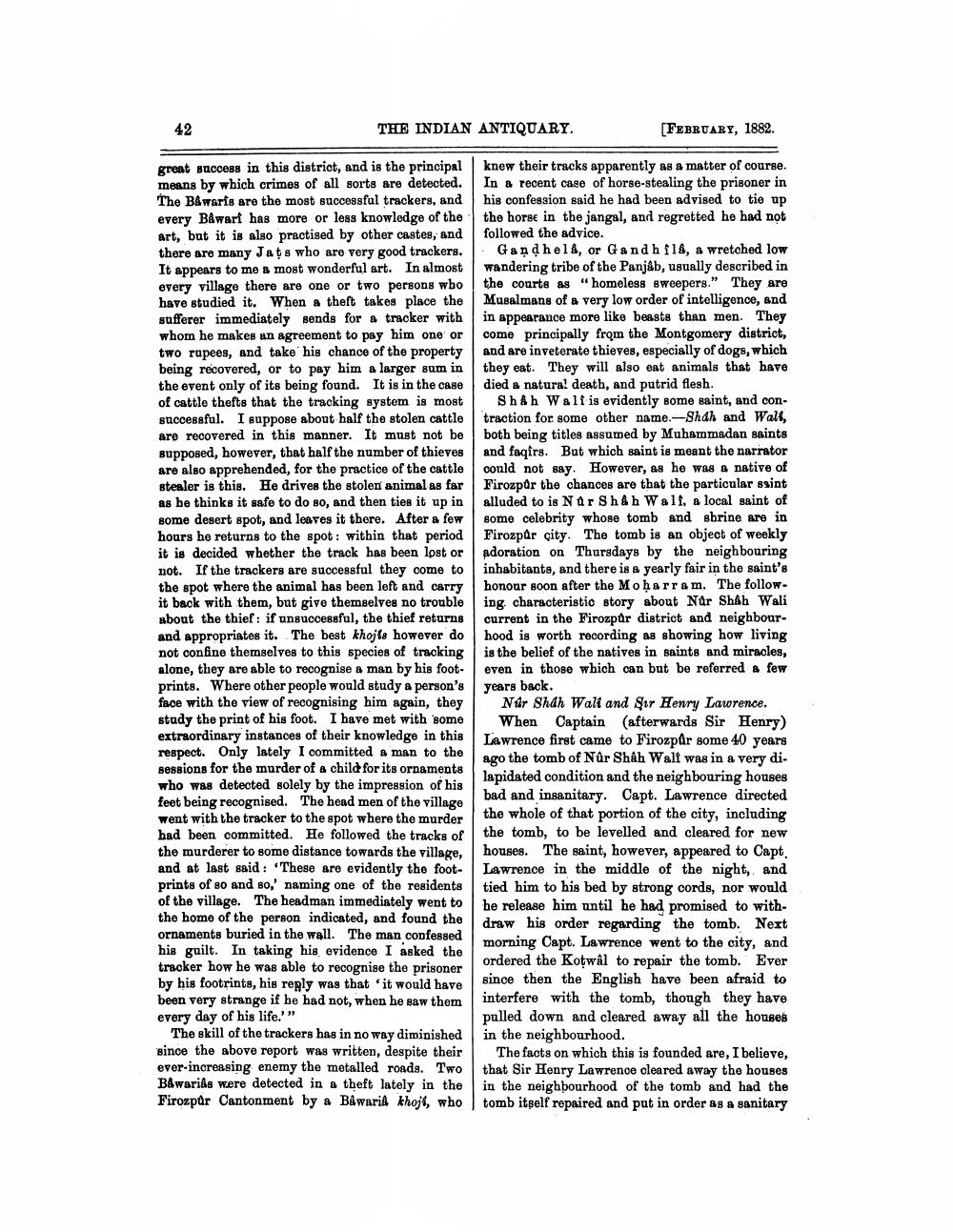________________
42
THE INDIAN ANTIQUARY.
[FEBRUARY, 1882.
great success in this district, and is the principal knew their tracks apparently as a matter of course. means by which crimes of all sorts are detected. In a recent case of horse-stealing the prisoner in The BAwarfs are the most successful trackers, and his confession said he had been advised to tio up every BAwarf has more or less knowledge of the the horse in the jangal, and regretted he had not art, but it is also practised by other castes, and followed the advice. there are many Jats who are very good trackers. • Gandheld, or Gandh 114, a wretched low It appears to me a most wonderful art. In almostwandering tribe of the Panjab, usually described in every village there are one or two persons who the courts as "homeless sweepers." They are have studied it. When a theft takes place the Musalmans of a very low order of intelligence, and sufferer immediately sends for a tracker with in appearance more like beasts than men. They whom he makes an agreement to pay him one or come principally from the Montgomery district, two rupees, and take his chance of the property and are inveterate thieves, especially of dogs, which being recovered, or to pay him a larger sum in they eat. They will also eat animals that have the event only of its being found. It is in the case died a natural death, and putrid flesh. of cattle thefts that the tracking system is most Sh&h Walf is evidently some saint, and consuccessful. I suppose about half the stolen cattle traction for some other name.--Shah and Wall, are recovered in this manner. It must not be both being titles assumed by Muhammadan saints supposed, however, that half the number of thieves and faqirs. But which saint is meant the narrator are also apprehended, for the practice of the cattle could not say. However, as he was a native of stealer is this. He drives the stolen animal as far Firozpur the chances are that the particular ssint as he thinks it safe to do so, and then ties it up in alluded to is Nar Shah Walt, a local saint of some desert spot, and leaves it there. After a few some celebrity whose tomb and shrine are in hours he returns to the spot : within that period Firozpār city. The tomb is an object of weekly it is decided whether the track has been lost or adoration on Thursdays by the neighbouring not. If the trackers are successful they come to inhabitants, and there is a yearly fair in the saint's the spot where the animal has been left and carry honour soon after the Moharram. The followit back with them, but give themselves no trouble ing characteristic story about Nar Shah Wali about the thief: if unsuccessful, the thief returns current in the Firozpur district and neighbourand appropriates it. The best khojte however do hood is worth recording as showing how living not confine themselves to this species of tracking is the belief of the natives in saints and miracles, alone, they are able to recognise a man by his foot. even in those which can but be referred a few prints. Where other people would study a person's
years back. face with the view of recognising him again, they Núr Shah Wali and Sir Henry Lawrence. study the print of his foot. I have met with some When Captain (afterwards Sir Henry) extraordinary instances of their knowledge in this Lawrence first came to Firozpār some 40 years respect. Only lately I committed a man to the
ago the tomb of Nûr Shah Walt was in a very di. sessions for the murder of a child for its ornaments who was detected solely by the impression of his
lapidated condition and the neighbouring houses feet being recognised. The head men of the village
bad and insanitary. Capt. Lawrence directed went with the tracker to the spot where the murder
the whole of that portion of the city, including had been committed. He followed the tracks of
the tomb, to be levelled and cleared for new the murderer to some distance towards the village, houses. The saint, however, appeared to Capt. and at last said: "These are evidently the foot- Lawrence in the middle of the night, and prints of so and so,' naming one of the residents tied him to his bed by strong cords, nor would of the village. The headman immediately went to he release him until he had promised to withthe home of the person indicated, and found the
draw his order regarding the tomb. Next ornaments buried in the wall. The man confessed his guilt. In taking his evidence I asked the
morning Capt. Lawrence went to the city, and tracker how he was able to recognise the prisoner
ordered the Kotwal to repair the tomb. Ever by his footrints, his reply was that it would have
since then the English have been afraid to been very strange if he had not, when he saw them interfere with the tomb, though they have every day of his life.'"
pulled down and cleared away all the houses The skill of the trackers has in no way diminished in the neighbourhood. since the above report was written, despite their The facts on which this is founded are, I believe, ever-increasing enemy the metalled roads. Two that Sir Henry Lawrence cleared away the houses Bawarifs were detected in a theft lately in the in the neighbourhood of the tomb and had the Firozpur Cantonment by a Bawaria khoji, who tomb itself repaired and put in order as a sanitary




